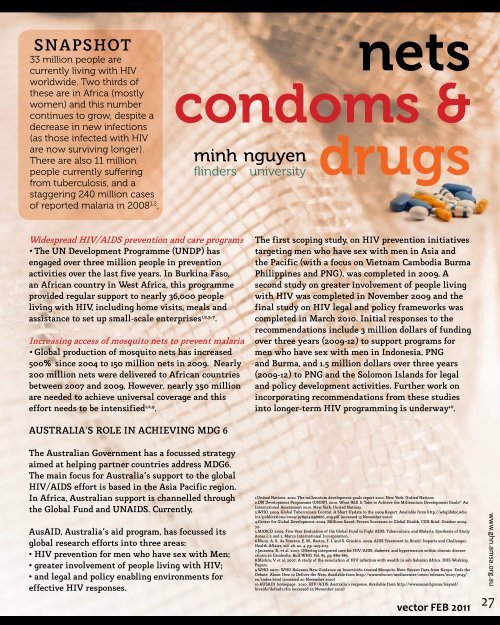You also want an ePaper? Increase the reach of your titles
YUMPU automatically turns print PDFs into web optimized ePapers that Google loves.
SNAPSHOT<br />
33 million people are<br />
currently living with HIV<br />
worldwide. Two thirds of<br />
these are in Africa (mostly<br />
women) and this number<br />
continues to grow, despite a<br />
decrease in new infections<br />
(as those infected with HIV<br />
are now surviving longer).<br />
There are also 11 million<br />
people currently suffering<br />
from tuberculosis, and a<br />
staggering 240 million cases<br />
of reported malaria in 2008 1,2 .<br />
nets<br />
condoms &<br />
drugs<br />
minh nguyen<br />
flinders university<br />
Widespread HIV/AIDS prevention and care programs<br />
• The UN Development Programme (UNDP) has<br />
engaged over three million people in prevention<br />
activities over the last five years. In Burkina Faso,<br />
an African country in West Africa, this programme<br />
provided regular support to nearly 36,000 people<br />
living with HIV, including home visits, meals and<br />
assistance to set up small-scale enterprises 1,2,5-7 . [<br />
Increasing access of mosquito nets to prevent malaria<br />
• Global production of mosquito nets has increased<br />
500% since 2004 to 150 million nets in 2009. Nearly<br />
200 million nets were delivered to African countries<br />
between 2007 and 2009. However, nearly 350 million<br />
are needed to achieve universal coverage and this<br />
effort needs to be intensified 1,2,9 .]<br />
•<br />
The first scoping study, on HIV prevention initiatives<br />
targeting men who have sex with men in Asia and<br />
the Pacific (with a focus on Vietnam Cambodia Burma<br />
Philippines and PNG), was completed in 2009. A<br />
second study on greater involvement of people living<br />
with HIV was completed in November 2009 and the<br />
final study on HIV legal and policy frameworks was<br />
completed in March 2010. Initial responses to the<br />
recommendations include 3 million dollars of funding<br />
over three years (2009-<strong>12</strong>) to support programs for<br />
men who have sex with men in Indonesia, PNG<br />
and Burma, and 1.5 million dollars over three years<br />
(2009-<strong>12</strong>) to PNG and the Solomon Islands for legal<br />
and policy development activities. Further work on<br />
incorporating recommendations from these studies<br />
into longer-term HIV programming is underway 10 .]<br />
Australia’s role in achieving MDG 6<br />
The Australian Government has a focussed strategy<br />
aimed at helping partner countries address MDG6.<br />
The main focus for Australia’s support to the global<br />
HIV/AIDS effort is based in the Asia Pacific region.<br />
In Africa, Australian support is channelled through<br />
the Global Fund and UNAIDS. Currently,<br />
AusAID, Australia’s aid program, has focussed its<br />
global research efforts into three areas:<br />
• HIV prevention for men who have sex with Men;<br />
• greater involvement of people living with HIV;<br />
• and legal and policy enabling environments for<br />
effective HIV responses.<br />
1.United Nations. 2010. The millennium development goals report 2010. New York: United Nations.<br />
2.UN Development Programme (UNDP). 2010. What Will It Take to Achieve the Millennium Development Goals? An<br />
International Assessment 2010. New York: United Nations.<br />
3.WHO. 2009. Global Tuberculosis Control: A Short Update to the 2009 Report. Available from http://whqlibdoc.who.<br />
int/publications/2009/9789241598866_eng.pdf (accessed 13 November 2010).<br />
4.Center for Global Development. 2004. Millions Saved: Proven Successes in Global Health. CGD Brief. October 2004,<br />
3:3.<br />
5.MARCO. 2009. Five-Year Evaluation of the Global Fund to Fight AIDS, Tuberculosis, and Malaria, Synthesis of Study<br />
Areas 1, 2 and 3, Marco International Incorporation.<br />
6.Nunn, A. S., da Fonseca, E. M., Bastos, F. I. and S. Gruskin. 2009. AIDS Treatment in Brazil: Impacts and Challenges.<br />
Health Affairs, vol. 28, no. 4, pp. 1103-1113.<br />
7.Janssens, B., et al. 2007. Offering integrated care for HIV/AIDS, diabetes, and hypertension within chronic disease<br />
clinics in Cambodia. Bull WHO, Vol. 85, pp. 880-885.<br />
8.Mishra, V. et al. 2007. A study of the association of HIV infection with wealth in sub-Saharan Africa. DHS Working<br />
Papers.<br />
9.WHO. 2007. WHO Releases New Guidance on Insecticide-treated Mosquito Nets: Recent Data from Kenya “Ends the<br />
Debate” About How to Deliver the Nets. Available from http://www.who.int/mediacentre/news/releases/2007/pr43/<br />
en/index.html (accessed 20 November 2010)<br />
10.AUSAID [homepage]. 2010. HIV/AIDS: Australia's response. Available from http://www.ausaid.gov.au/keyaid/<br />
hivaids/default.cfm (accessed 22 November 2010)<br />
www.ghn.amsa.org.au<br />
vector FEB <strong>2011</strong><br />
27

















